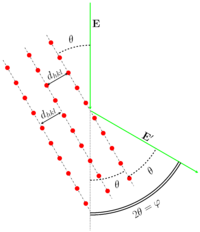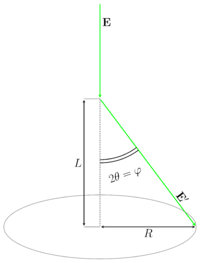Standard
Standards in GED
Standards are used in GED for calibration of electron wavelength or nozzle position. There are two kinds of them:
| Type of standard | Examples |
|---|---|
| Gas | C6H6, CCl4, CO2, CS2 |
| Polycrystalline | ZnO, TlCl |
Polycrystalline standards
Theoretical considerations
Bragg-Wolf equation
The scattering on the polycrystalline sample can be described with the Bragg-Wolf equation:
<math> 2d_{hkl} \sin \theta = n \lambda , </math>
where hkl - are Miller indexes, dhkl is a distance between hkl crystallographic planes, θ - is a reflection angle from the corresponding plane, n - is positive integer. The GED usually operates with the scattering angle φ. The relationship between θ and φ is <math>\varphi=2\theta</math> (see pictures). The scattering angle φ is usually calculated in GED from the scattered ring radius R and distance between scattering center and the registration device L. As it is easily seen from the illustration the formula for this angle is: <math>\varphi=\arctan( \frac{R}{L} )</math>. Therefore the substitution of the scattering angle φ into the Bragg-Wolf formula results the equation for the wavelength determination:
<math> \lambda = \frac{2d_{hkl}}{n}\sin (\frac{1}{2} \arctan ( \frac{R}{L} ) ) . </math>
Calculation of the interplane distance
The distances between the cystallographic planes can be calculated from the lattice parameters:
- unit cell edges lengths a, b, c,
- angles between edges α, β, γ.
The general formula is:
<math> \frac{1}{d_{hkl}^2} = \frac{1}{s} [ (\frac{h\sin\alpha}{a})^2 + (\frac{k\sin\beta}{b})^2 +\\ + (\frac{l\sin\gamma}{c})^2 + 2 \frac{hk}{ab}(\cos\alpha \cdot \cos\beta - \cos\gamma) + 2 \frac{hl}{ac}(\cos\alpha \cdot \cos\gamma - \cos\beta) + 2 \frac{kl}{bc}(\cos\beta \cdot \cos\gamma - \cos\alpha) ], </math> where <math>s= 1 - \cos^2 \alpha - \cos^2 \beta - \cos^2 \gamma + 2 \cos\alpha \cos\beta \cos\gamma </math>. This formula is easily simplified to smaller equations for the cases of lattices more symmetrical then the triclinic one. For example, in the case of hexagonal lattice, where <math>a=b\neq c</math>, <math>\alpha=\beta=90^{\circ}</math>, <math>\gamma = 120^{\circ}</math> the equation for dhkl would be:
<math> \frac{1}{d_{hkl}^2} = \frac{4}{3}\frac{h^2+hk+k^2}{a^2} + \frac{l^2}{c^2} . </math>
The common polycrystall standards
The most widely used polycrystalline standard is the zinc oxide ZnO. Several reasons are behind its' prevalence.
- It is simple to prepare. The metal Zn is burned to yielding a ZnO in a form of smoke that is condensed on the wire net substrate.
- It has only one stable crystal modification in the usual GED experimental conditions.
- It is cheap.
- ???
- PROFIT!!!

